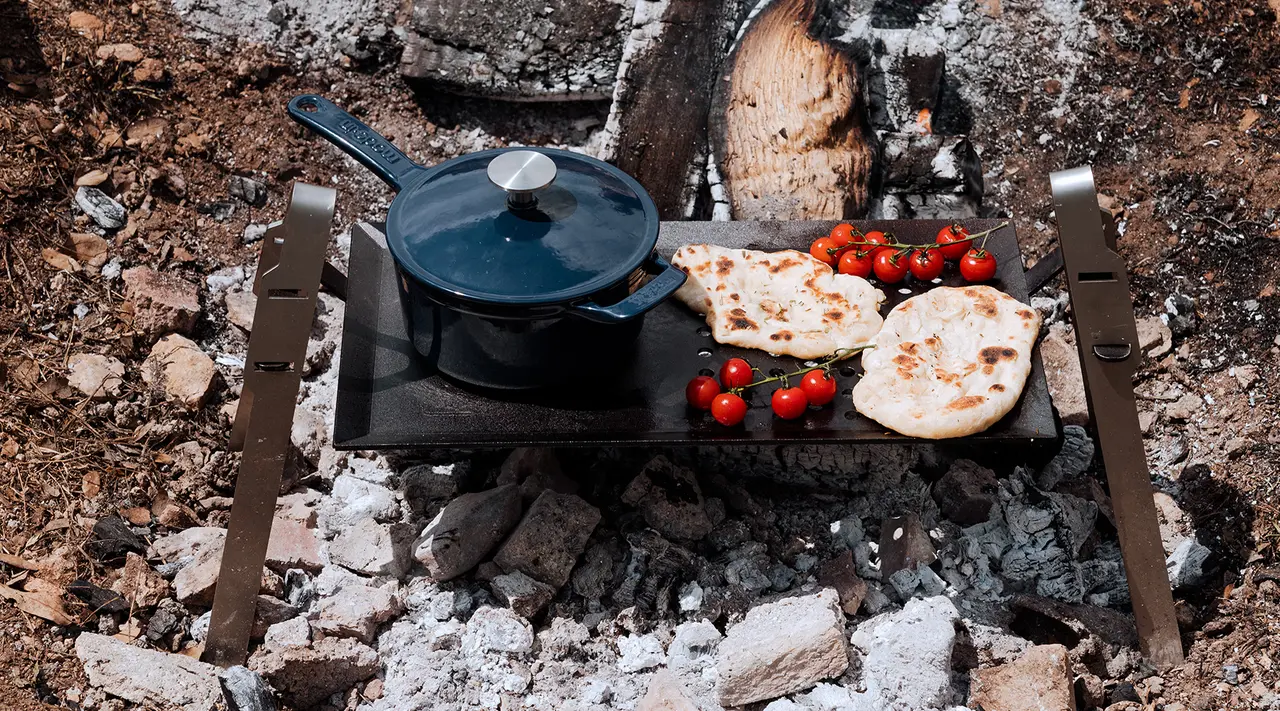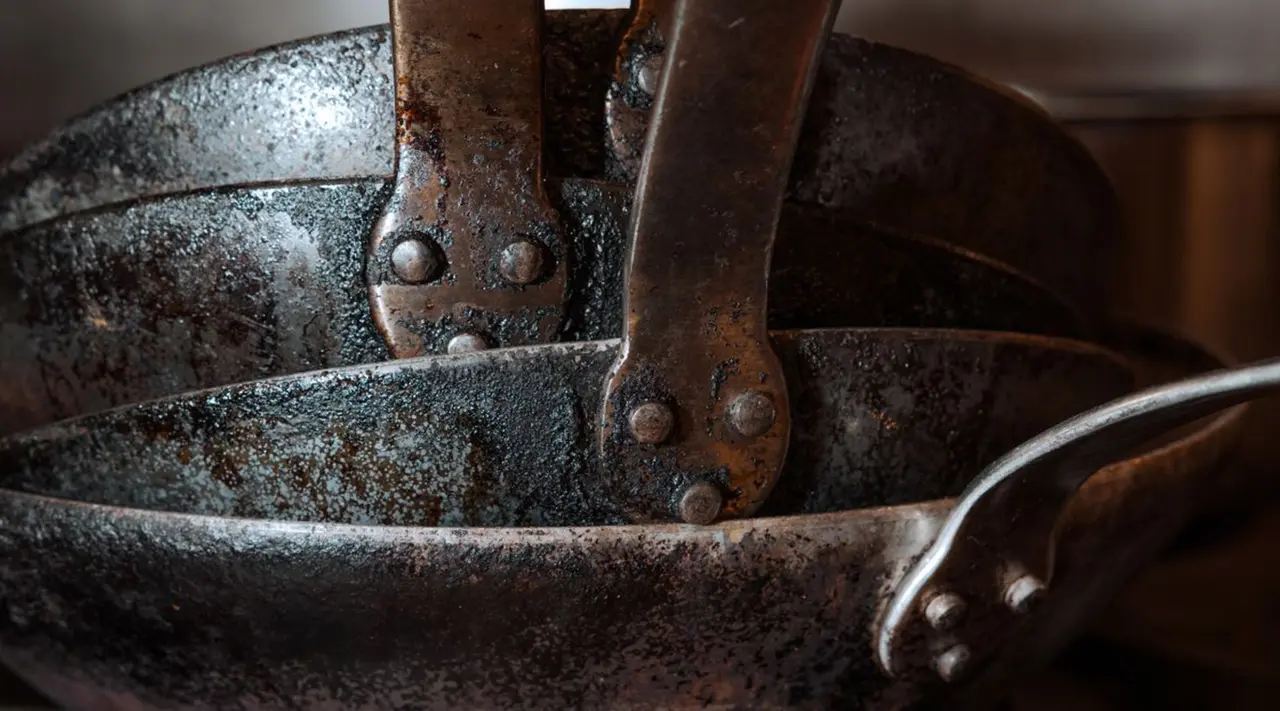Even with our combined years of home cooking experience, we’ve had our fair share of kitchen disasters. On the plus side, however, this also means we’ve had plenty of experience scrubbing the charred, sticky remains of our dinner out of saucepans and stock pots.
Below, we’re sharing some of our tried-and-true methods. Here’s how to restore your stainless steel, non stick, and enameled cast iron pots to their shiny best, no matter how bad the mess.
How to Clean Burnt Stainless Steel Pots

Much like wearing a new pencil down into a nub, it can feel devastating to see that the gleaming finish on your stainless steel pot has been replaced by burns, stains, and mineral deposits. The good news? Stainless steel cookware—especially our 5-ply Stainless Clad Cookware —is almost impossible to ruin. Here are a few ways to bring back that signature shine, depending on how badly burned it is.
Level 1: Mineral Deposits
Caused by a buildup of calcium or mineral sulfites found in some tap water, mineral (or calcium) deposits often show up as a cloudy, whitish residue on your stainless steel pot. They’re not exactly the same thing as a burn, but are still important to remove, as they can harbor bacteria.
- Add enough water to cover any mineral deposits on the inside of your pot, then add a few tablespoons of vinegar. Bring mixture to a simmer.
- After 5 minutes, cut the heat, then use a wooden spoon or spatula to gently scrape up the mineral deposits. Let cool completely, then wash with soapy water and dry thoroughly.
Level 2: Rainbow Tint
Your pot can develop a rainbow “stain” or tint—also called a heat tint—when it’s heated to high enough temperatures over enough time. While it doesn’t affect your pot’s performance, it can make it look less than pristine.
Luckily, removing a rainbow tint is a total cinch: simply add enough white vinegar to your pot to cover the discolored areas, work it in with a sponge, and dump out the vinegar and rinse the pot with water. Once clean, dry thoroughly.
Level 3: Seriously Burned or Discolored Pans
If your pot is discolored from overheating, or you’re dealing with a burnt mess that won’t come off with regular scrubbing, don’t panic.
- Make a paste with one part each baking soda and vinegar. Coat the inside of the pot with the baking soda and vinegar paste, spreading it evenly over the burnt parts.
- Let sit for a minute or two, then rinse and dry.
Alternatively, if you have a special stainless steel cleaner (like our Make It Like New Cleaner), sprinkle a small amount onto the burnt parts of your pot and work it in with a non-abrasive sponge. Rinse with warm water and dry.
How to Clean Burnt Non Stick Pots

Cleaning a burnt non stick pot is a little trickier than cleaning stainless steel—not because it’s inherently difficult, but because a little too much elbow grease can permanently damage the layers of non stick coating the inside of the pot.
While non stick cookware isn’t going to last quite as long as something like stainless steel, you can easily extend your pot’s lifespan with proper maintenance. Whereas you might use an abrasive sponge or scrubber to clean stainless steel or enameled cast iron, non stick requires a softer touch. Here’s how to gently—but effectively—get rid of burnt-on, sticky messes.
Level 1: Just Water
Fill your non stick pot with enough water to completely cover the burnt parts. Bring it to a simmer, then use a non-abrasive tool—such as a wooden or silicone spatula or spoon—to gently scrape up the mess. This should help get rid of most, if not all, of the burnt-on bits.
Level 2: Vinegar and Baking Soda
If water alone isn’t doing the trick, you may need to bring in the big guns—i.e., vinegar and baking soda. Add a couple of teaspoons each to your pot, mixing thoroughly. Simmer the mixture until the rest of the stuck-on bits have dissolved, a couple of minutes or so. Cut the heat, letting the pot cool completely before giving it a final scrub with soapy water.
How to Clean Burnt Enameled Cast Iron Pots

Enamel is a fantastic, durable substance, but it’s not indestructible. Like non stick, enamel can scratch easily, and it should never see the inside of a dishwasher. Here are three ways to clean a burnt enameled cast iron pot.
Level 1: Burnt-On Food
In this situation, you’re dealing with food that’s burnt on to the bottom of your pot, but not completely carbonized (i.e. a blackened, unrecognizable mess). Warm soapy water and a quick soak is typically all you’ll need for this level of mess.
- Using a non-metal spatula or spoon (again, we like wood or silicone), gently scrape as much of the burnt food out of the pot as you can.
- Fill your pot with warm water and a few drops of dish soap, using your spatula or spoon to remove the rest of the burnt food. You can let the pot soak for up to an hour, but not longer than that. Rinse and dry your pot thoroughly.
Level 2: Carbonized Food
At this level, your food is completely blackened and burned beyond all recognition. This type of mess is a little trickier to deal with—but definitely not impossible.
- Fill pot with warm, soapy water and place on the stove over medium heat. As you wait for the pot to simmer, use your spatula or spoon to gently dislodge the bits of food as they come loose.
- Once the pot is simmering, cut the heat and allow it to cool down completely. Wash with more warm soapy water, then rinse and dry.
- If there’s any remaining discoloration on the bottom of your pot after drying, you can easily remove it using a specially formulated cleaner, such as our Ceramic Cleaner, or Bar Keepers Friend. Pour a small amount of the cleaner into the pot, then use a non-abrasive sponge to gently rub it into the stained areas. Rinse the pot again and then dry.
Level 3: Burnt-On (Polymerized) Oil
This is what happens when oil becomes chemically bonded to the surface of the pot, characterized by sticky, often rainbow-tinted spots where the oil gets burnt on.
While this can be helpful for seasoning your unfinished cast iron cookware, you don’t want it on your enameled cast iron. To remove it, simply add some of your ceramic cleaner or Bar Keeper’s friend to the inside of the pot, using the abrasive side of a dish sponge to lift the burnt oil. Repeat as needed, including the underside of your pot if necessary, then rinse and dry.
Ready to Cook?
Cleaning burnt pots isn’t just about removing the mess itself: it’s also about respecting the cookware, and knowing how to treat different materials and coatings without damaging them. Running an enameled cast iron pot through the dishwasher, for example, is a recipe for disaster— likewise for non stick.
Now that you know how easy it is to clean your pots by hand (with the aid of a few quality cleaning products), however, you can spend less time worrying and more time enjoying your time in the kitchen—and at the dinner table.
























